oil pressure Hyundai Equus 2016 Owner's Manual
[x] Cancel search | Manufacturer: HYUNDAI, Model Year: 2016, Model line: Equus, Model: Hyundai Equus 2016Pages: 477, PDF Size: 16.25 MB
Page 19 of 477
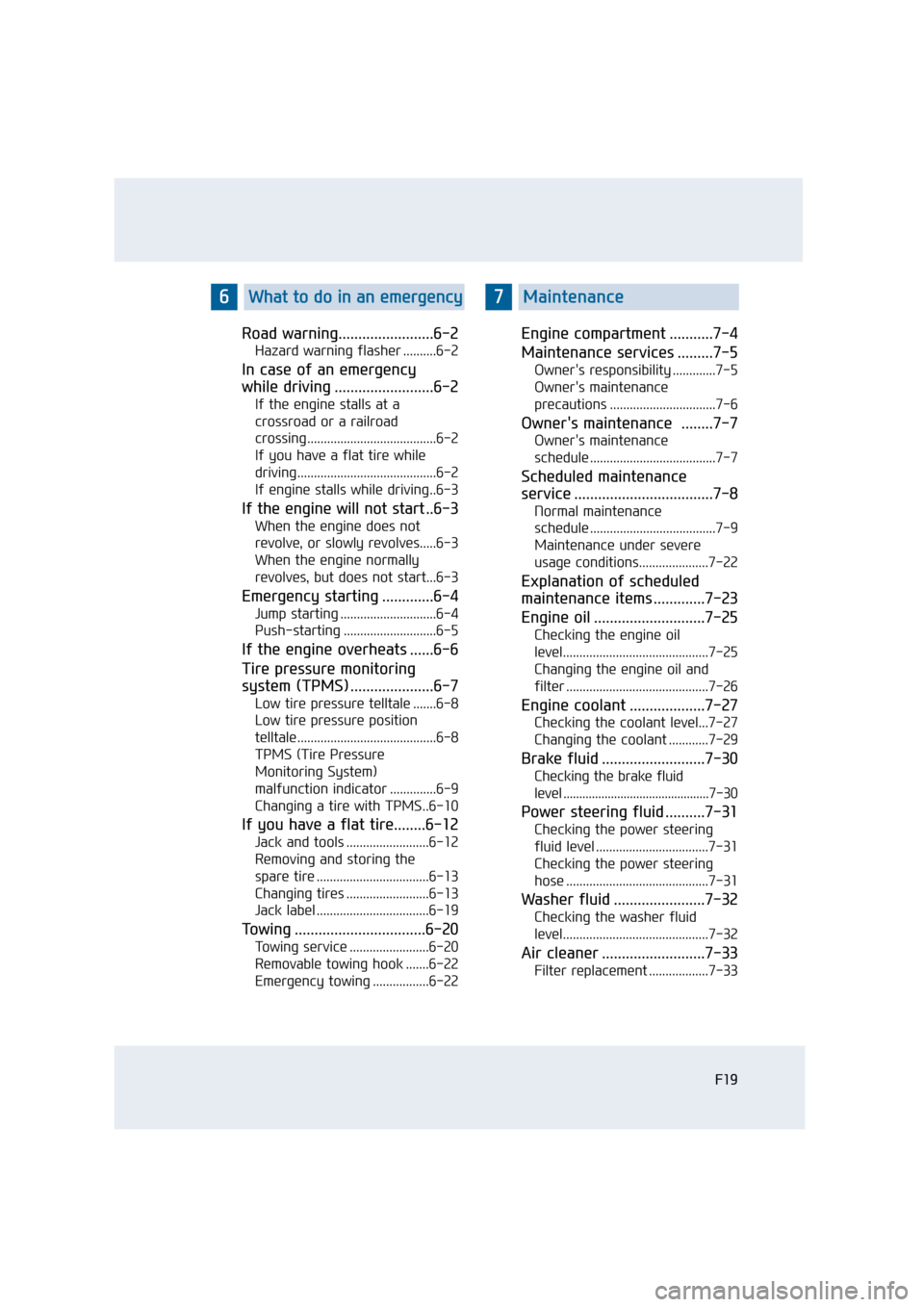
Road warning........................6-2
Hazard warning flasher ..........6-2
In case of an emergency
while driving .........................6-2
If the engine stalls at a
crossroad or a railroad
crossing.......................................6-2
If you have a flat tire while
driving..........................................6-2
If engine stalls while driving..6-3
If the engine will not start ..6-3
When the engine does not
revolve, or slowly revolves.....6-3
When the engine normally
revolves, but does not start...6-3
Emergency starting .............6-4
Jump starting .............................6-4
Push-starting ............................6-5
If the engine overheats ......6-6
Tire pressure monitoring
system (TPMS) .....................6-7
Low tire pressure telltale .......6-8
Low tire pressure position
telltale..........................................6-8
TPMS (Tire Pressure
Monitoring System)
malfunction indicator ..............6-9
Changing a tire with TPMS..6-10
If you have a flat tire........6-12
Jack and tools .........................6-12
Removing and storing the
spare tire ..................................6-13
Changing tires .........................6-13
Jack label ..................................6-19
Towing .................................6-20
Towing service ........................6-20
Removable towing hook .......6-22
Emergency towing .................6-22
Engine compartment ...........7-4
Maintenance services .........7-5
Owner's responsibility .............7-5
Owner's maintenance
precautions ................................7-6
Owner's maintenance ........7-7
Owner's maintenance
schedule ......................................7-7
Scheduled maintenance
service ...................................7-8
Normal maintenance
schedule ......................................7-9
Maintenance under severe
usage conditions.....................7-22
Explanation of scheduled
maintenance items .............7-23
Engine oil ............................7-25
Checking the engine oil
level............................................7-25
Changing the engine oil and
filter ...........................................7-26
Engine coolant ...................7-27
Checking the coolant level...7-27
Changing the coolant ............7-29
Brake fluid ..........................7-30
Checking the brake fluid
level ..............................................7-30
Power steering fluid ..........7-31
Checking the power steering
fluid level ..................................7-31
Checking the power steering
hose ...........................................7-31
Washer fluid .......................7-32
Checking the washer fluid
level............................................7-32
Air cleaner ..........................7-33
Filter replacement ..................7-33
F19
6What to do in an emergency7Maintenance
Page 187 of 477
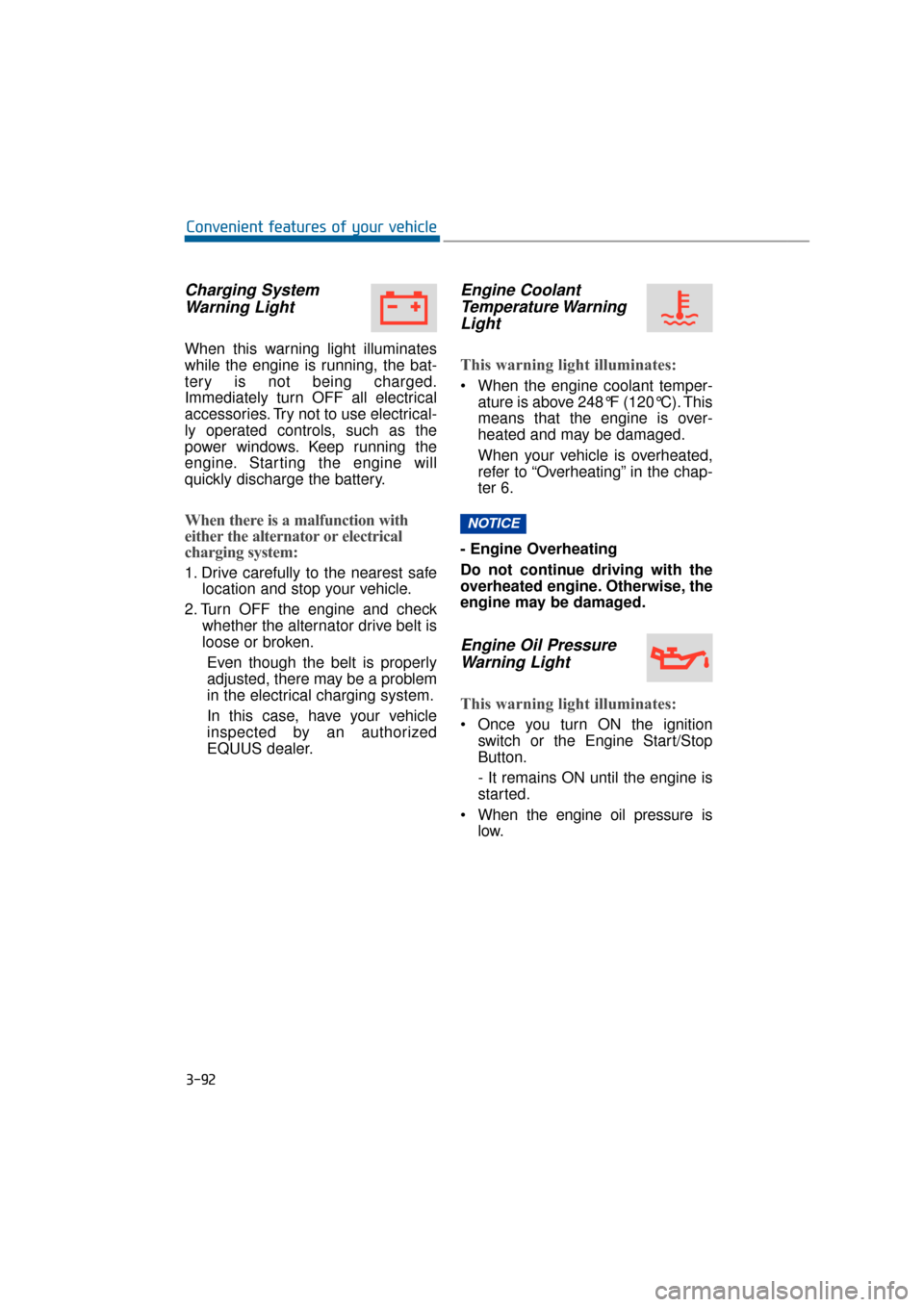
Charging SystemWarning Light
When this warning light illuminates
while the engine is running, the bat-
tery is not being charged.
Immediately turn OFF all electrical
accessories. Try not to use electrical-
ly operated controls, such as the
power windows. Keep running the
engine. Starting the engine will
quickly discharge the battery.
When there is a malfunction with
either the alternator or electrical
charging system:
1. Drive carefully to the nearest safe location and stop your vehicle.
2. Turn OFF the engine and check whether the alternator drive belt is
loose or broken.
Even though the belt is properly
adjusted, there may be a problem
in the electrical charging system.
In this case, have your vehicle
inspected by an authorized
EQUUS dealer.
Engine CoolantTemperature WarningLight
This warning light illuminates:
When the engine coolant temper-
ature is above 248°F (120°C). This
means that the engine is over-
heated and may be damaged.
When your vehicle is overheated,
refer to “Overheating” in the chap-
ter 6.
- Engine Overheating
Do not continue driving with the
overheated engine. Otherwise, the
engine may be damaged.
Engine Oil Pressure Warning Light
This warning light illuminates:
Once you turn ON the ignition
switch or the Engine Start/Stop
Button.
- It remains ON until the engine is
started.
When the engine oil pressure is low.
NOTICE
3-92
Convenient features of your vehicle
Page 188 of 477
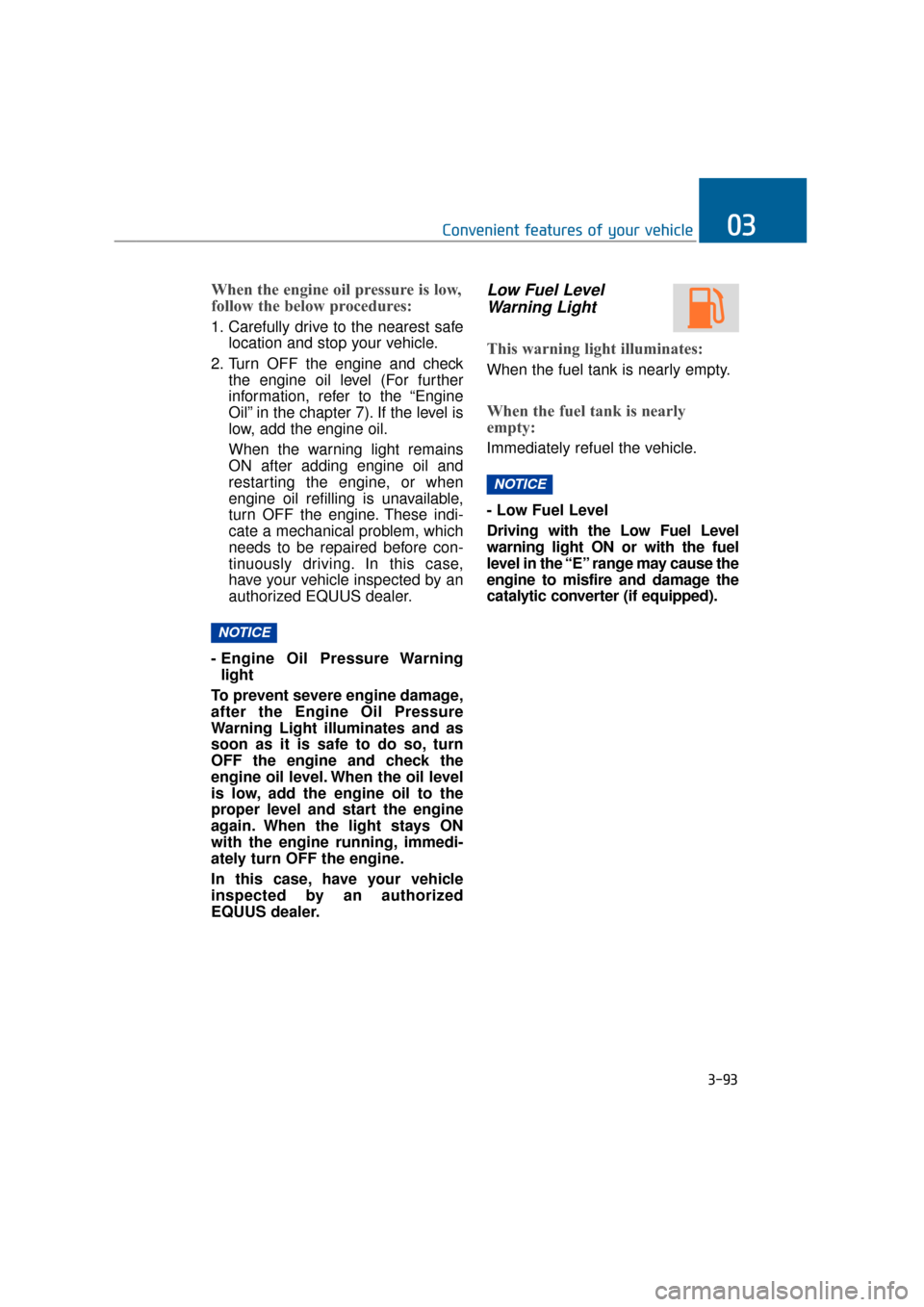
When the engine oil pressure is low,
follow the below procedures:
1. Carefully drive to the nearest safelocation and stop your vehicle.
2. Turn OFF the engine and check the engine oil level (For further
information, refer to the “Engine
Oil” in the chapter 7). If the level is
low, add the engine oil.
When the warning light remains
ON after adding engine oil and
restarting the engine, or when
engine oil refilling is unavailable,
turn OFF the engine. These indi-
cate a mechanical problem, which
needs to be repaired before con-
tinuously driving. In this case,
have your vehicle inspected by an
authorized EQUUS dealer.
- Engine Oil Pressure Warning light
To prevent severe engine damage,
after the Engine Oil Pressure
Warning Light illuminates and as
soon as it is safe to do so, turn
OFF the engine and check the
engine oil level. When the oil level
is low, add the engine oil to the
proper level and start the engine
again. When the light stays ON
with the engine running, immedi-
ately turn OFF the engine.
In this case, have your vehicle
inspected by an authorized
EQUUS dealer.
Low Fuel Level Warning Light
This warning light illuminates:
When the fuel tank is nearly empty.
When the fuel tank is nearly
empty:
Immediately refuel the vehicle.
- Low Fuel Level
Driving with the Low Fuel Level
warning light ON or with the fuel
level in the “E” range may cause the
engine to misfire and damage the
catalytic converter (if equipped).
NOTICE
NOTICE
3-93
Convenient features of your vehicle03
Page 322 of 477
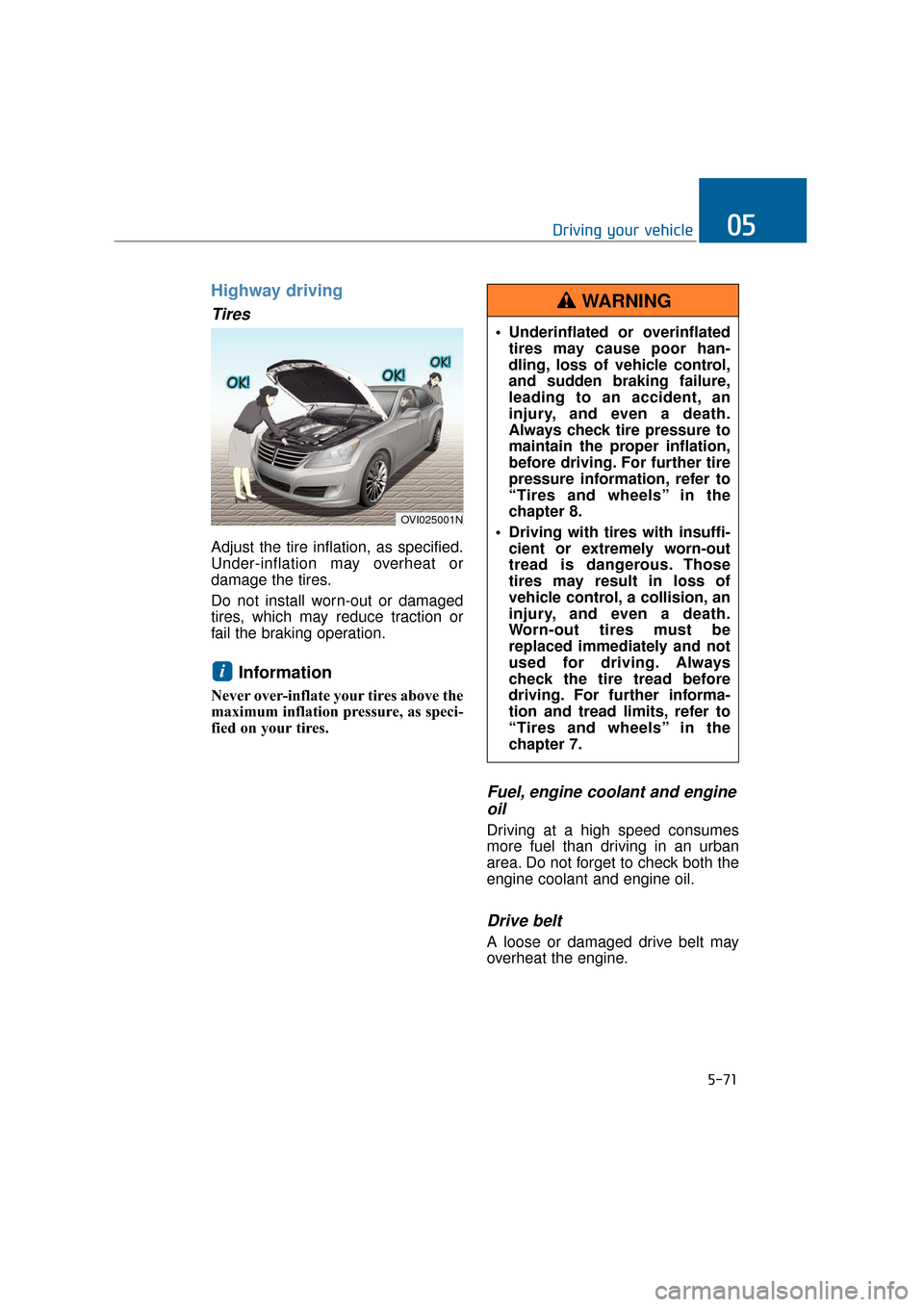
5-71
Driving your vehicle05
Highway driving
Tires
Adjust the tire inflation, as specified.
Under-inflation may overheat or
damage the tires.
Do not install worn-out or damaged
tires, which may reduce traction or
fail the braking operation.
Information
Never over-inflate your tires above the
maximum inflation pressure, as speci-
fied on your tires.
Fuel, engine coolant and engineoil
Driving at a high speed consumes
more fuel than driving in an urban
area. Do not forget to check both the
engine coolant and engine oil.
Drive belt
A loose or damaged drive belt may
overheat the engine.
i
OVI025001N
Underinflated or overinflated
tires may cause poor han-
dling, loss of vehicle control,
and sudden braking failure,
leading to an accident, an
injury, and even a death.
Always check tire pressure to
maintain the proper inflation,
before driving. For further tire
pressure information, refer to
“Tires and wheels” in the
chapter 8.
Driving with tires with insuffi- cient or extremely worn-out
tread is dangerous. Those
tires may result in loss of
vehicle control, a collision, an
injury, and even a death.
Worn-out tires must be
replaced immediately and not
used for driving. Always
check the tire tread before
driving. For further informa-
tion and tread limits, refer to
“Tires and wheels” in the
chapter 7.
WARNING
Page 364 of 477
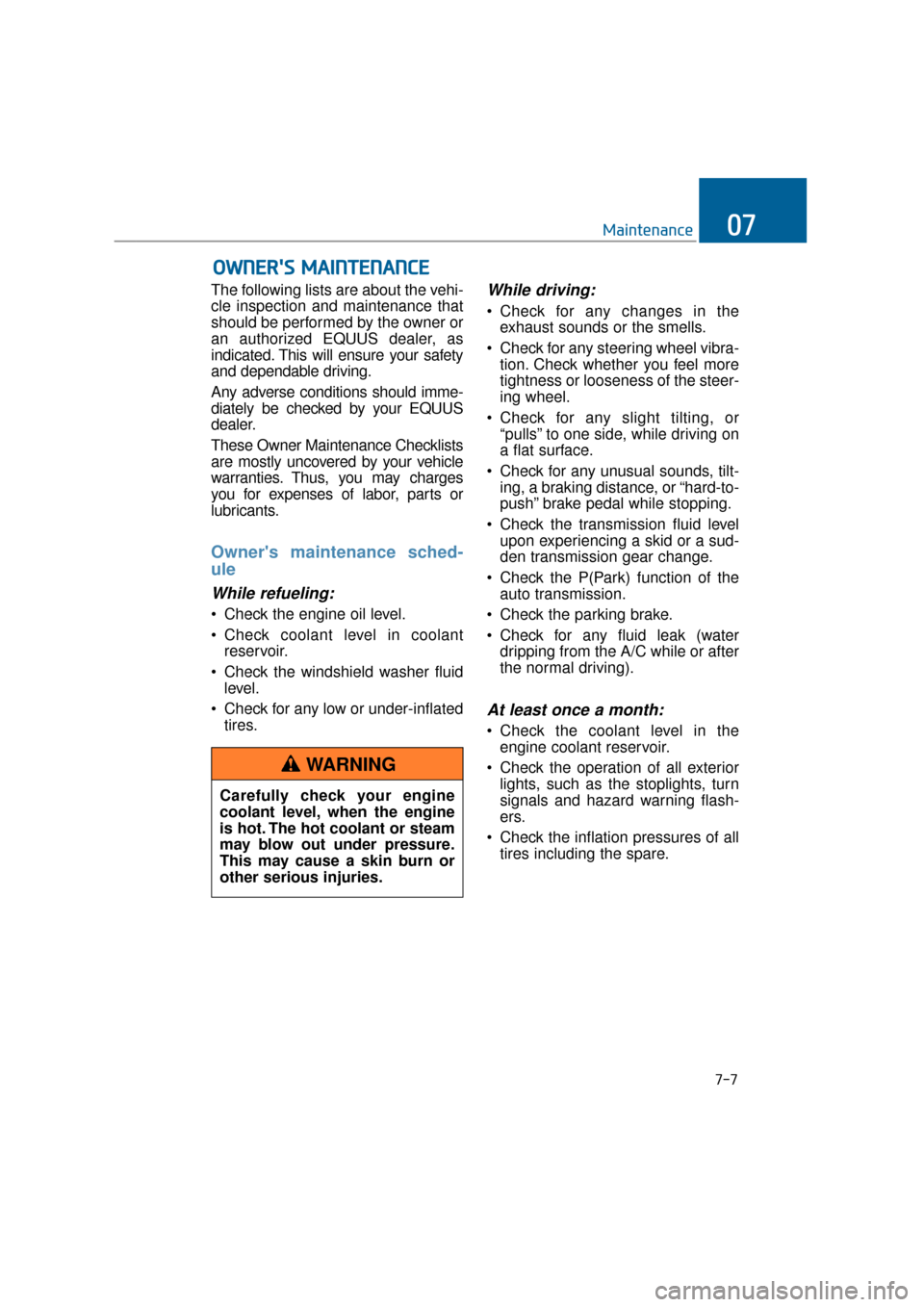
The following lists are about the vehi-
cle inspection and maintenance that
should be performed by the owner or
an authorized EQUUS dealer, as
indicated. This will ensure your safety
and dependable driving.
Any adverse conditions should imme-
diately be checked by your EQUUS
dealer.
These Owner Maintenance Checklists
are mostly uncovered by your vehicle
warranties. Thus, you may charges
you for expenses of labor, parts or
lubricants.
Owner's maintenance sched-
ule
While refueling:
Check the engine oil level.
Check coolant level in coolantreservoir.
Check the windshield washer fluid level.
Check for any low or under-inflated tires.
While driving:
Check for any changes in theexhaust sounds or the smells.
Check for any steering wheel vibra- tion. Check whether you feel more
tightness or looseness of the steer-
ing wheel.
Check for any slight tilting, or “pulls” to one side, while driving on
a flat surface.
Check for any unusual sounds, tilt- ing, a braking distance, or “hard-to-
push” brake pedal while stopping.
Check the transmission fluid level upon experiencing a skid or a sud-
den transmission gear change.
Check the P(Park) function of the auto transmission.
Check the parking brake.
Check for any fluid leak (water dripping from the A/C while or after
the normal driving).
At least once a month:
Check the coolant level in theengine coolant reservoir.
Check the operation of all exterior lights, such as the stoplights, turn
signals and hazard warning flash-
ers.
Check the inflation pressures of all tires including the spare.
O OW
W N
NE
ER
R '
'S
S
M
M A
AI
IN
N T
TE
EN
N A
AN
N C
CE
E
7-7
Maintenance07
Carefully check your engine
coolant level, when the engine
is hot. The hot coolant or steam
may blow out under pressure.
This may cause a skin burn or
other serious injuries.
WARNING
Page 409 of 477
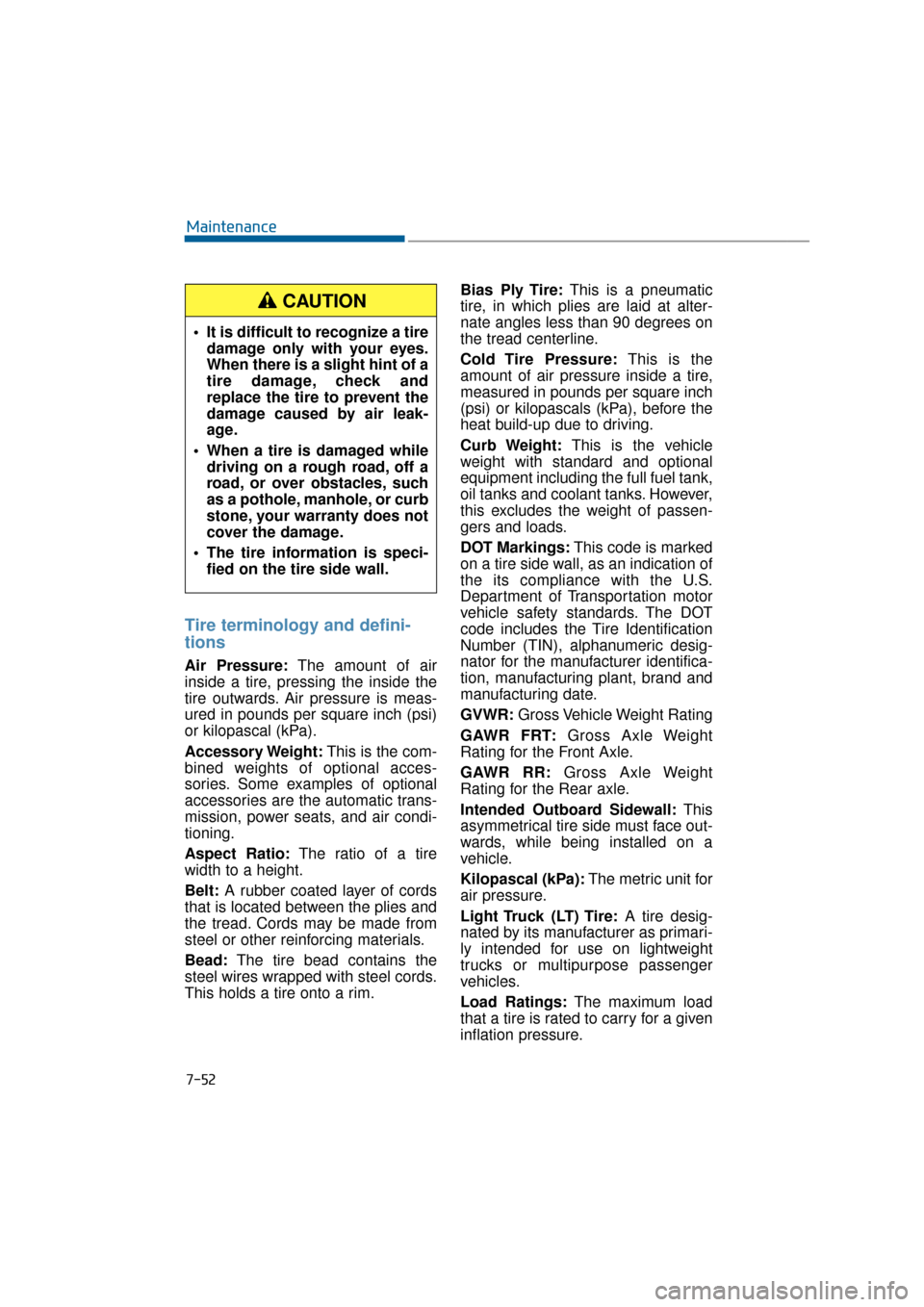
7-52
Maintenance
Tire terminology and defini-
tions
Air Pressure:The amount of air
inside a tire, pressing the inside the
tire outwards. Air pressure is meas-
ured in pounds per square inch (psi)
or kilopascal (kPa).
Accessory Weight: This is the com-
bined weights of optional acces-
sories. Some examples of optional
accessories are the automatic trans-
mission, power seats, and air condi-
tioning.
Aspect Ratio: The ratio of a tire
width to a height.
Belt: A rubber coated layer of cords
that is located between the plies and
the tread. Cords may be made from
steel or other reinforcing materials.
Bead: The tire bead contains the
steel wires wrapped with steel cords.
This holds a tire onto a rim. Bias Ply Tire:
This is a pneumatic
tire, in which plies are laid at alter-
nate angles less than 90 degrees on
the tread centerline.
Cold Tire Pressure: This is the
amount of air pressure inside a tire,
measured in pounds per square inch
(psi) or kilopascals (kPa), before the
heat build-up due to driving.
Curb Weight: This is the vehicle
weight with standard and optional
equipment including the full fuel tank,
oil tanks and coolant tanks. However,
this excludes the weight of passen-
gers and loads.
DOT Markings: This code is marked
on a tire side wall, as an indication of
the its compliance with the U.S.
Department of Transportation motor
vehicle safety standards. The DOT
code includes the Tire Identification
Number (TIN), alphanumeric desig-
nator for the manufacturer identifica-
tion, manufacturing plant, brand and
manufacturing date.
GVWR: Gross Vehicle Weight Rating
GAWR FRT: Gross Axle Weight
Rating for the Front Axle.
GAWR RR: Gross Axle Weight
Rating for the Rear axle.
Intended Outboard Sidewall: This
asymmetrical tire side must face out-
wards, while being installed on a
vehicle.
Kilopascal (kPa): The metric unit for
air pressure.
Light Truck (LT) Tire: A tire desig-
nated by its manufacturer as primari-
ly intended for use on lightweight
trucks or multipurpose passenger
vehicles.
Load Ratings: The maximum load
that a tire is rated to carry for a given
inflation pressure.
• It is difficult to recognize a tire
damage only with your eyes.
When there is a slight hint of a
tire damage, check and
replace the tire to prevent the
damage caused by air leak-
age.
When a tire is damaged while driving on a rough road, off a
road, or over obstacles, such
as a pothole, manhole, or curb
stone, your warranty does not
cover the damage.
The tire information is speci- fied on the tire side wall.
CAUTION
Page 441 of 477
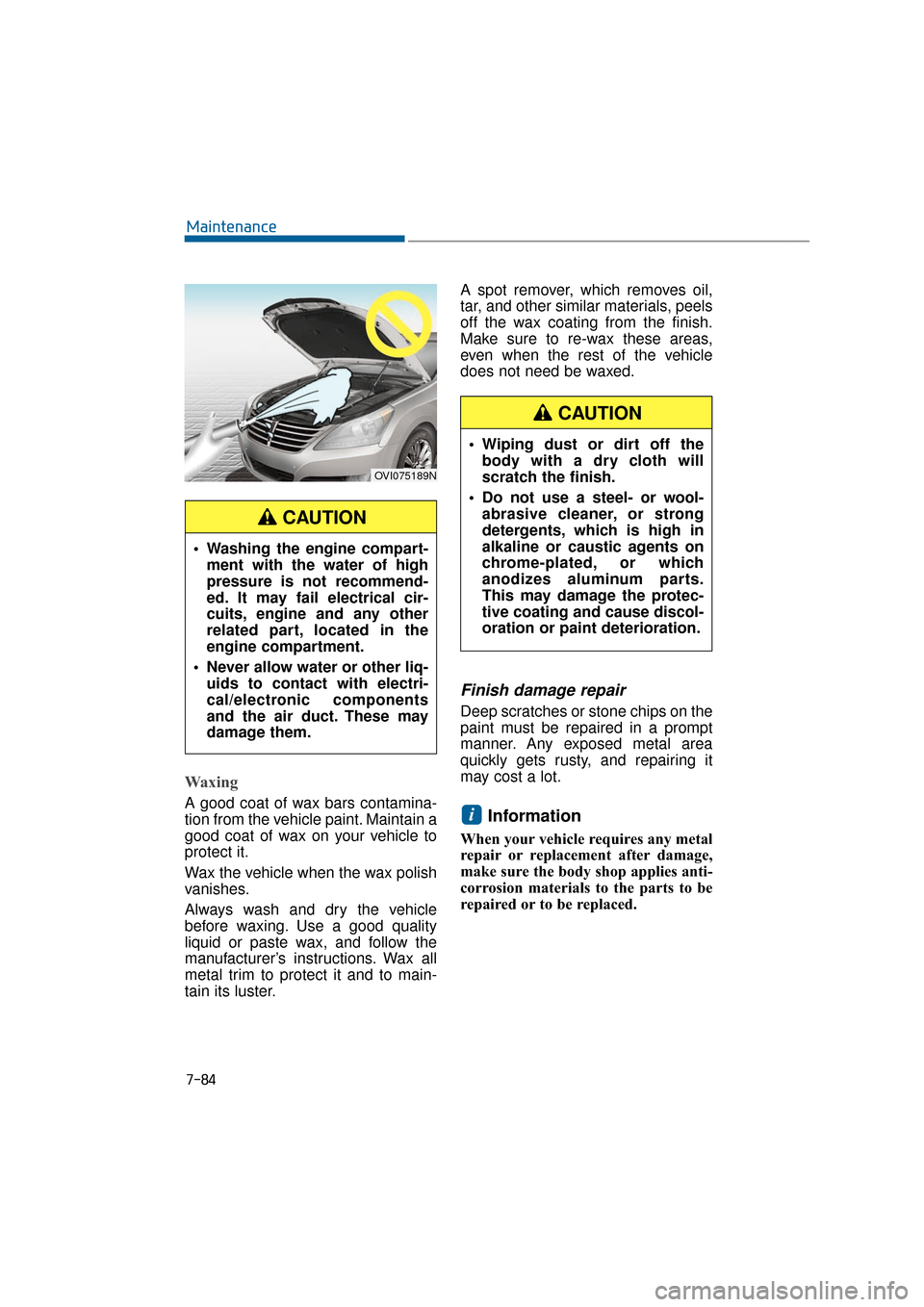
7-84
Maintenance
Waxing
A good coat of wax bars contamina-
tion from the vehicle paint. Maintain a
good coat of wax on your vehicle to
protect it.
Wax the vehicle when the wax polish
vanishes.
Always wash and dry the vehicle
before waxing. Use a good quality
liquid or paste wax, and follow the
manufacturer’s instructions. Wax all
metal trim to protect it and to main-
tain its luster.A spot remover, which removes oil,
tar, and other similar materials, peels
off the wax coating from the finish.
Make sure to re-wax these areas,
even when the rest of the vehicle
does not need be waxed.
Finish damage repair
Deep scratches or stone chips on the
paint must be repaired in a prompt
manner. Any exposed metal area
quickly gets rusty, and repairing it
may cost a lot.
Information
When your vehicle requires any metal
repair or replacement after damage,
make sure the body shop applies anti-
corrosion materials to the parts to be
repaired or to be replaced.
i
Washing the engine compart-
ment with the water of high
pressure is not recommend-
ed. It may fail electrical cir-
cuits, engine and any other
related part, located in the
engine compartment.
Never allow water or other liq- uids to contact with electri-
cal/electronic components
and the air duct. These may
damage them.
CAUTION
Wiping dust or dirt off thebody with a dry cloth will
scratch the finish.
Do not use a steel- or wool- abrasive cleaner, or strong
detergents, which is high in
alkaline or caustic agents on
chrome-plated, or which
anodizes aluminum parts.
This may damage the protec-
tive coating and cause discol-
oration or paint deterioration.
CAUTION
OVI075189N
Page 469 of 477
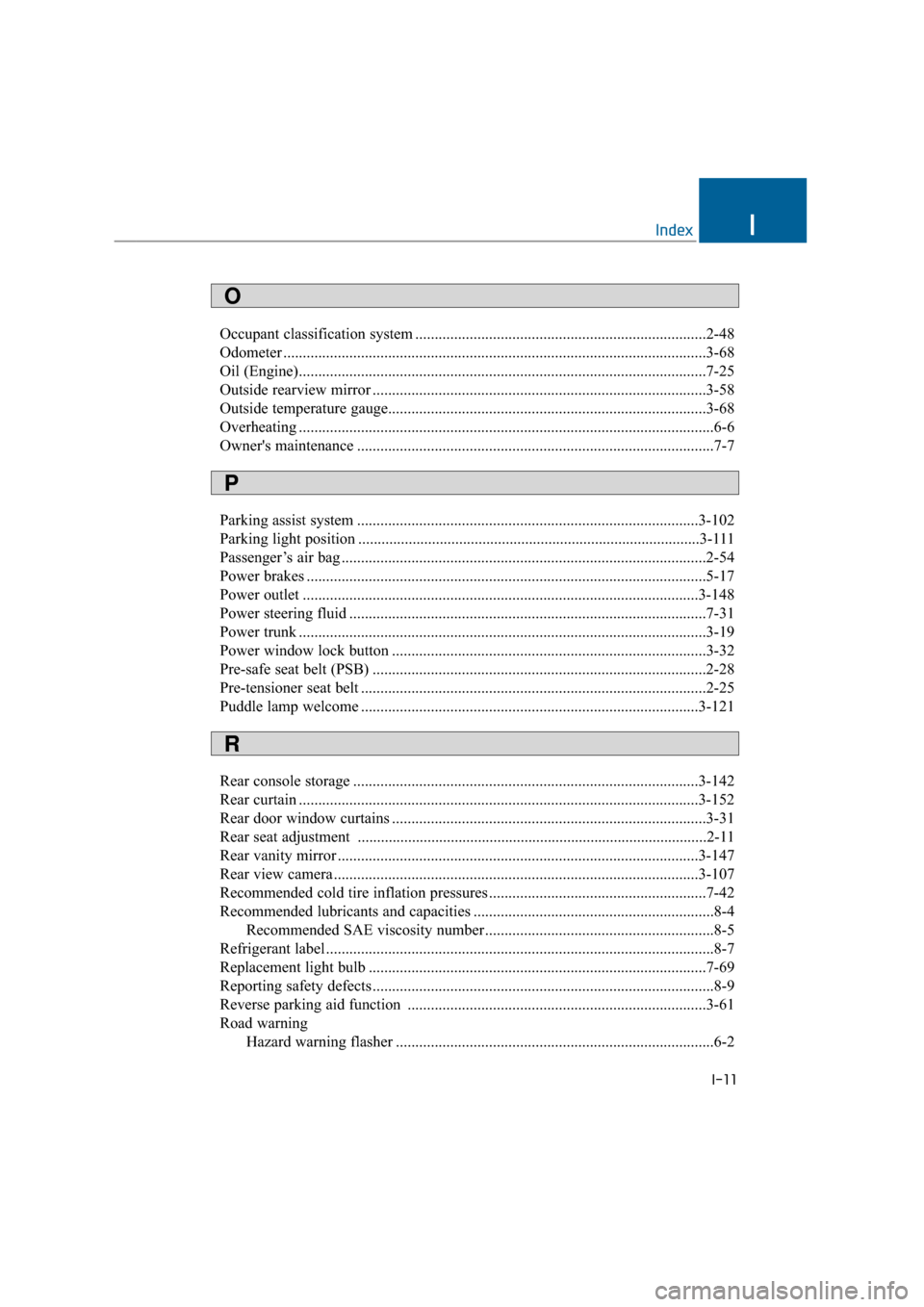
Occupant classification system ........................................................................\
...2-48
Odometer ........................................................................\
.....................................3-68
Oil (Engine)........................................................................\
.................................7-25
Outside rearview mirror ........................................................................\
..............3-58
Outside temperature gauge........................................................................\
..........3-68
Overheating ........................................................................\
...................................6-6
Owner's maintenance ........................................................................\
....................7-7
Parking assist system ........................................................................\
................3-102
Parking light position ........................................................................\
................3-111
Passenger’s air bag ........................................................................\
......................2-54
Power brakes ........................................................................\
...............................5-17
Power outlet ........................................................................\
..............................3-148
Power steering fluid ........................................................................\
....................7-31
Power trunk ........................................................................\
.................................3-19
Power window lock button ........................................................................\
.........3-32
Pre-safe seat belt (PSB) ........................................................................\
..............2-28
Pre-tensioner seat belt ........................................................................\
.................2-25
Puddle lamp welcome ........................................................................\
...............3-121
Rear console storage ........................................................................\
.................3-142
Rear curtain ........................................................................\
...............................3-152
Rear door window curtains ........................................................................\
.........3-31
Rear seat adjustment ........................................................................\
..................2-11
Rear vanity mirror ........................................................................\
.....................3-147
Rear view camera ........................................................................\
......................3-107
Recommended cold tire inflation pressures ........................................................7-42
Recommended lubricants and capacities ..............................................................8-4Recommended SAE viscosity number ...........................................................8-5
Refrigerant label ........................................................................\
............................8-7
Replacement light bulb ........................................................................\
...............7-69
Reporting safety defects ........................................................................\
................8-9
Reverse parking aid function ........................................................................\
.....3-61
Road warning Hazard warning flasher ........................................................................\
..........6-2
I-11
IndexI
O
P
R